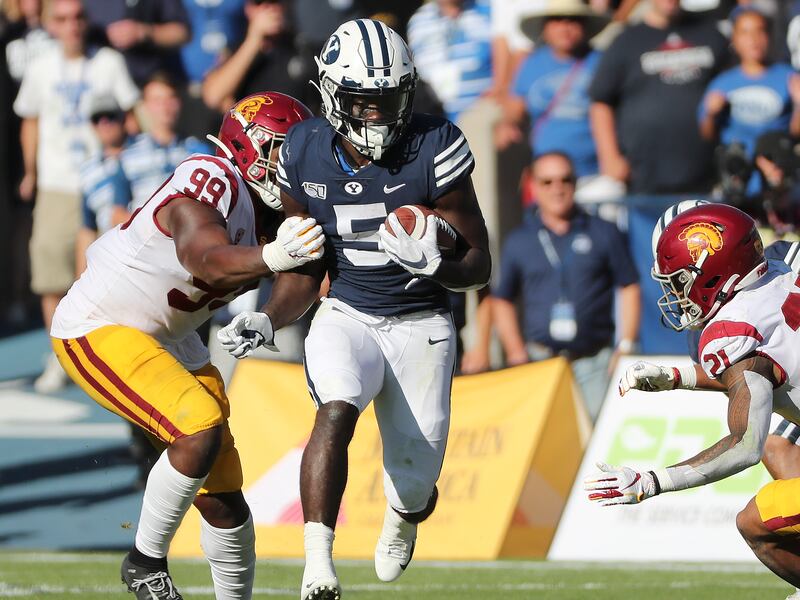PROVO — Will BYU football try a redo of Ty’Son Williams from South Carolina by trying to bring in another senior graduate transfer to bolster its running back group for 2020?
It might be a strategy since the last time we saw the Cougars in the Hawaii Bowl, the main featured back, Lopini Katoa, limped off the field. Upstart freshman Sione Finau is now rehabbing his knee following ACL surgery after an injury suffered in practice in November.
“You can see how important it is in BYU’s offense when they have a back like Ty’Son Williams or a Jamaal Williams,” said Moose Bingham, vice president of War Room and Utah Preps Podcast and former on-campus recruiter with the Cougars’ football program.
“When a defense has to worry about a strong run attack, it opens up the rest of the offense. So, yes, it is important that they have an effective run threat to make a defense account for something other than the passing game.”
Bingham said BYU currently has a stable of young backs who might work as a committee, but it really makes a difference to get an elite back. “Right now it’s a mix-and-match and playing to their individual strengths. The ideal is to find a back who can do everything you need.”
In so many ways, this is a repeat of how the Cougars entered the 2019 offseason when Kalani Sitake decided to go after Williams and Rice University’s Emmanuel Esukpa.
But even then, as history has taught the program, bringing in a graduate transfer is a 50-50 proposition. There are reasons such players leave schools in the first place. Most of the time it is for more playing time. For others, they are coming off injuries and looking for a new start.
Last year BYU hit it 50-50 with Williams, who excelled until injured against Washington, while the injured Esukpa struggled to get playing time. Before that, Stanford transfer Keanu Nelson saw meager playing time at receiver (2014), while UTEP transfer receiver Jordan Leslie made a big impact (also 2014).
Running backs coach AJ Steward is in the middle of a developmental program with Katoa, Finau and Jackson McChesney but said before the bowl game that he is continuing to work to improve the group and find the best option.
Bingham said turning to a true freshman is tough, but he has been impressed with 2020 signee Bruce Garrett from Texarkana, Texas. Garrett helped his high school team to three consecutive state championship game appearances and set a school record with 2,004 rushing yards.
In Garrett, BYU coaches may have found an elite back who can come in early and make a difference. Or not.
“I really like Garrett. He runs hard, he can block and he can catch the ball out of the backfield. They need a guy like him to step up just like they need McChesney and others to quickly develop and play at a high level,” Bingham added.
This week in an interview with Ben Criddle on ESPN 960, Bingham said he had researched a half-dozen graduate transfers who might fit in at BYU and be potential recruiting targets.
Bingham said a tweak in the NCAA’s graduate transfer rules will make it easier for schools to absorb a one-year player. Before, graduate programs at schools were hesitant to bring in football players because they took competitive spots from highly qualified and serious academic applicants. The failure rate and dropouts were astounding.
A new rule supposedly would allow those transfers to sign up for eight hours of any kind of classes just to get through school for their football purposes and not impact graduate school admissions.
Here are Bingham’s targets BYU may be pursuing:
Trevor Speights, Stanford, 5-10, 200 pounds, from Memorial High, McAllen, Texas, who was a four-star recruit, three-time all-state and ranked No. 4 in Texas High School history in rushing. Speights did not play in 2019 at Stanford and had 59 carries for 221 yards and one touchdown as a junior.
Brittain Brown, Duke University, 6-1, 200 pounds from Canton, Georgia. He gained 1,126 yards and scored 10 touchdowns at Duke.
Jacob Kibodi, a 6-2, 218-pound running back at Texas A&M from Baton Rouge, Louisiana. Kibodi has rushed 31 times for 123 yards and a touchdown for the Aggies.
Tru Wilson, 5-10, 202 pounds from Warren, Michigan, has appeared in 25 games, 20 of those at the running back position for Michigan.
Others include Shawndarrius Phillips, 5-1, 226, from Florida international, and Damontay Rhem, 5-11, 215, from North Carolina State.
BYU’s top rushers in 2019 were Finau (359 yards), Katoa (358), McChesney (274), Williams (264) and Esukpa (190).
That run threat, either by committee or a rising prospect, will have to be more productive in 2020. The Cougars face another challenging September with games at Utah, a home game against Michigan State and road contests at Arizona State and Minnesota.


 alt=Dick Harmon
alt=Dick Harmon